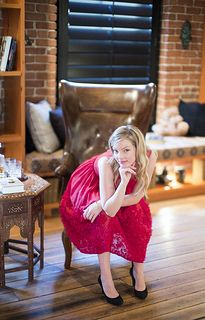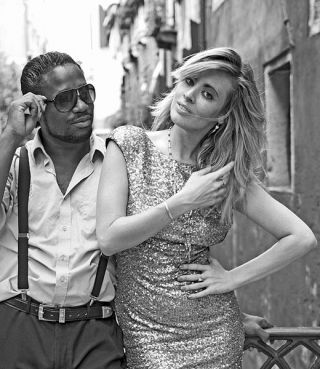Personality
Seven Fashion Secrets for Romance
How you dress may matter for relationship success.
Posted February 7, 2014

by Christopher.Michel
What to wear, what to wear… it’s date night and you’re standing in front of your closet trying to make a decision. The clock is ticking and your mind is engaged in rapid-fire hypotheticals: “What if I wear my dark dressy jeans and that cream colored sweater?” “What about that shirt with the cute ruffles?” “Is a button-down really not a dress shirt?” Caught in the fashion dilemma, we can turn to psychological research and gain insight into the choices we make, the process of deciding, and the impressions we create when we wear what we wear on date night.
1. Looking for love? Try red.
You know that song “Lady in Red”? Recent evidence suggests men have a powerful response to women wearing red, seeing them as more attractive and sexually desirable than if they wear other colors (Elliot & Niesta, 2008). The seductive effect of red has been documented for not only American men, but men from around the world suggesting it may be a global, culturally-universal phenomenon (Elliot, Tracy, Pazda, & Beall, 2013). Because red works its enchanting effects outside of conscious awareness, adding red to your date-night fashion is an easy way to help capture the attention of a desirable partner.
2. Not into red? Try black.
Is black the new red? Maybe! Both men and women perceive members of the opposite sex as more attractive when they wear red or black, as compared to green or yellow or white (Roberts, Owen, & Havlicek, 2010). The effect of wearing black may be not only in the eye of the beholder, but also the wearer. Photos of men wearing black shirts were still seen as more attractive than when they wore other colors (e.g., yellow) even after the experimenters digitally removed shirt color from the photo. How you feel in your clothing may be half the story when it comes to how others perceive you.
3. Let your clothes do the talking.
Going on a first date? When asking yourself what you should wear, maybe you should ask what kind impression you want to make. Subtle differences in attire, such as wearing an off-the-rack or a made-to-measure suit, can influence impressions of confidence, success, and flexibility (Howlett, Pine, Orakcioglu, & Fletcher, 2013). A more dressy or a more artsy style of clothing can generate impressions of greater intelligence as compared to more casual styles or wearing sweatshirts (Behling & Williams, 1991), but a dressy style might also communicate an uneasiness in social situations or a tendency to depend on others (Paek, 1986). More conservative styles may communicate self-control, reliability, and understanding, while more daring styles can be more attractive, suggesting that the person is unique and interesting (Paek, 1986).
4. Don’t forget your shoes.
New evidence shows that people form ideas about other peoples’ personalities based on the shoes that they wear (Gillath, Bahns, Ge, & Crandall, 2012). When asked to guess owners’ personalities based only on their shoes, different observers often infer the same personality from any given shoe. They tend to think shiny shoes convey anxiety, pointy shoes suggest less agreeableness, and higher heels or pointy shoes signal less emotional stability. But are these impressions accurate? In some cases. Observers tend to be good at guessing strangers’ anxiety and agreeableness based only on their shoes (Gillath et al., 2012).
by Supercatwalk 5. Show some skin… or not?
Factors outside of our awareness can influence our clothing choices. For example, on any given day, women’s fashion interests seem to reflect their reproductive viability. Unlike for many species, the exact timing of female ovulation for humans is concealed, hidden from easy observation. However, recent evidence suggests that the kinds of outfits women would want to wear to a social gathering are linked to their ovulation (Durante, Li, & Haselton, 2008). Women prefer more revealing clothing during periods of peak fertility, particularly if they are single, sexually experienced, or in a relationship but also very happy in that relationship.

by Supercatwalk
5. Show some skin… or not?
6. Ruffles, lace, and that cute necklace
In the same way that women have a natural inclination towards revealing clothing during the peak fertility, they also dress more fashionably as a function of their cycle (Haselton, Mortezaie, Pillsworth, Bleske-Rechek, & Frederick, 2007). A recent study took photographs of women during different stages in their cycle. Judges picked out the photo in which the person looked like they were trying to be attractive, and it turns out, judges tended to pick the photo that happened to be taken when the woman was most fertile. During peak fertility women seem to unconsciously adorn themselves in more attractive and fashionable clothing.
7. Dress with care.
It may matter less what you wear, and more how you wear it. Bringing care to how you look is linked to perceptions of attractiveness. People respond more positively to those who are well-groomed and have a neat and clean presentation (Mehrabian & Blum, 1997). They feel more pleasure in the presence of those who bring care to their appearance and feel more attentive and alert. The lesson here is that taking good care of yourself sends a positive message, regardless of which outfit you end up choosing.

by FahionbyHe
Behling, D. U., & Williams, E. A. (1991). Influence of dress on perception of intelligence and expectations of scholastic achievement. Clothing and Textiles Research Journal, 9(4), 1-7.
Durante, K. M., Li, N. P., & Haselton, M. G. (2008). Changes in women's choice of dress across the ovulatory cycle: Naturalistic and laboratory task-based evidence. Personality and Social Psychology Bulletin, 34(11), 1451-1460.
Elliot, A. J., & Niesta, D. (2008). Romantic red: red enhances men's attraction to women. Journal of personality and social psychology, 95(5), 1150-1164.
Elliot, A. J., Tracy, J. L., Pazda, A. D., & Beall, A. T. (2013). Red enhances women's attractiveness to men: First evidence suggesting universality. Journal of Experimental Social Psychology, 49, 165-168.
Haselton, M. G., Mortezaie, M., Pillsworth, E. G., Bleske-Rechek, A., & Frederick, D. A. (2007). Ovulatory shifts in human female ornamentation: Near ovulation, women dress to impress. Hormones and Behavior, 51(1), 40-45.
Howlett, N., Pine, K., Orakçioglu, I., & Fletcher, B. (2013). The influence of clothing on first impressions: Rapid and positive responses to minor changes in male attire. Journal of Fashion Marketing and Management, 17(1), 38-48.
Mehrabian, A., & Blum, J. S. (1997). Physical appearance, attractiveness, and the mediating role of emotions. Current Psychology, 16(1), 20-42.
Paek, S. L. (1986). Effect of garment style on the perception of personal traits. Clothing and Textiles Research Journal, 5(1), 10-16.
Roberts, S. C., Owen, R. C., & Havlicek, J. (2010). Distinguishing between perceiver and wearer effects in clothing color-associated attributions. Evolutionary Psychology: an International Journal of Evolutionary Approaches to Psychology and Behavior, 8, 350-364.




